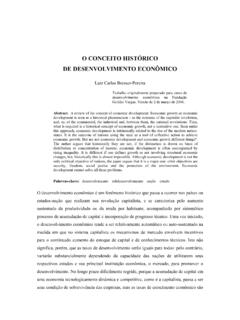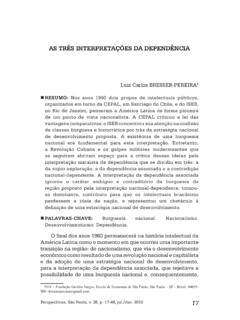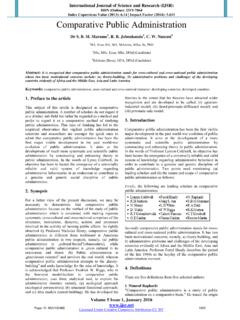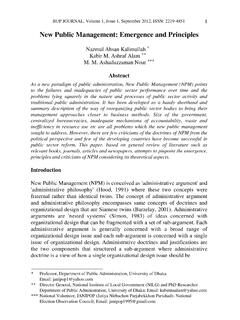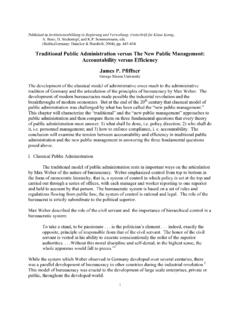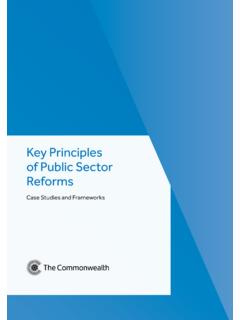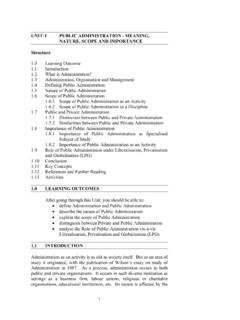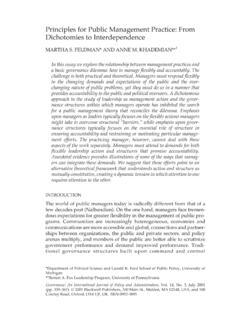Transcription of PRACTICAL PRINCIPLES FOR PUBLIC ADMINISTRATION
1 PRACTICAL PRINCIPLES FOR PUBLIC ADMINISTRATION Luiz Carlos Bresser-Pereira Communication to the Fourth Annual Meeting of the Committee of Experts on PUBLIC ADMINISTRATION , of the Economic and Social Council (Ecosoc), of the United Nations. New York, April 6, 2005. PUBLIC ADMINISTRATION plays a central role on the Millennium Development Goals (MDGs) because they will only be achieved to the extent that the national states in the developing countries count with state organizations strong enough to promote them. In the case of the poorer countries, for which the attainment of these goals will depend on the support of developed countries through the UN system international institutions, such aid also will depend on the governance capacity of each country and particularly on the quality of the more general instrument of collective action they count with: the state organization and its PUBLIC ADMINISTRATION .
2 In each country, the strength or capability of the state organization depends, first, on its democratic political institutions, that make the rule of law effective, human rights, assured, and the government or ADMINISTRATION , legitimate. It depends, second, on the quality of its PUBLIC policies, particularly of their economic and social policies, which lead to the achievement of such objectives at a more operational, decision-making, level. It depends, third, on the quality of PUBLIC ADMINISTRATION , which implements these laws and policies a PUBLIC ADMINISTRATION which, in the past, was essentially required to be effective, but that today, with the increase of social services provided by the state, is also required to be efficient. The strategic core of the government must count with professional senior civil services of the highest quality working together with elected politicians in taking government decisions.
3 On the other hand, each government must design a decentralized state structure, and make agencies accountable for results rather than for procedures, in order to provide with efficiency the social and scientific services that characterize modern democracies. A major contribution that the United Nations may give to its member countries is to offer a broad and flexible definition of PRACTICAL PRINCIPLES of PUBLIC ADMINISTRATION consistent with the Millennium Development Goals. PRINCIPLES that, once applied, will increase state capability by making the strategic core of the state more effective, and social 2and scientific services more efficient. Given, however, the enormous heterogeneity of economic and political development of the member countries, is it realistic to try to devise such PRINCIPLES ?
4 I believe that the answer is yes , provided that such PRINCIPLES follow a bottom-up approach, , that they are simple, almost self-evident, without being just common sense; that they are operational, offering PRACTICAL guidance while making countries free to adopt the administrative institutions and practices that they view as adequate; and that, before being approved, they are subject to a broad discussion. The secretary of this Committee prepared an excellent document to serve as basis for our discussion, Bottom-up Approaches and Methodologies to Develop Foundations and PRINCIPLES of PUBLIC ADMINISTRATION : The Example of Criteria-Based Organizational Assessment , from now on called Bottom-up Approach Document. As it observes in its first pages, there are some PRINCIPLES of PUBLIC ADMINISTRATION that are widely accepted today.
5 These PRINCIPLES should include transparency and accountability, participation and pluralism, subsidiarity, efficiency and effectiveness, and equity and access to services . Yet, the document adds, the challenge is to bridge wide gaps that exist between the theory and practice of PUBLIC ADMINISTRATION .1 In defining the operational PRINCIPLES of PUBLIC ADMINISTRATION , I believe that it will be required, on one hand, to take into consideration these general PRINCIPLES , and, on the other, the PRACTICAL requirements of an operational principle. The document distinguishes the Standardized PRINCIPLES of ADMINISTRATION from the Criteria Based approach, and opts for the second. The standardized PRINCIPLES face the classical problems of the one size fits all approach.
6 The criteria based approaches avoid this problem by defining themselves as sharing a common assumption: that organizations meeting key elements of critical criteria have the capacity to be effective and high performing, even if no specific performance measures are analyzed .2 I agree with this approach, but I believe that the Committee, following this line of thinking, should additionally consider PRINCIPLES that are operational and structural. By operational PRINCIPLES I understand PRINCIPLES that involve a reasonably clear and pragmatic course of action. That are flexible to allow for interpretation, but are simple and straightforward to 1 United Nations Economic and Social Council (2005) Bottom-up Approaches and Methodologies to Develop Foundations and PRINCIPLES of PUBLIC ADMINISTRATION : The Example of Criteria-Based Organizational Assessment , p.
7 6. 3facilitate implementation. By adding the word structural , I mean that the PRINCIPLES will require, to be applied, some structural changes in the organization of the state changes that are not limited to organization chart reforms but involve the type of property of the agencies executing services financed with tax resources. These operational and structural PRINCIPLES should be divided in three sections, referring, respectively, to state structure, civil service, and management In relation to the state structure, the question is not if the state should be unitary or federal, but to know which services are supposed to be performed directly by the state, through the use of statutory civil servants, and which should the state outsource to third parties while keeping responsibility over them.
8 In modern PUBLIC ADMINISTRATION there is a clear line of action. The state should provide directly, through its civil service, only the services that involve specific state activities, , the activities that involve the use of state power, or that control the state s resources. The other activities that the state finances are auxiliary activities, like catering, or construction, or cleaning services, that are outsourced competitively to business enterprises, and social and scientific services, which are supposed to be outsourced to decentralized agencies or to non governmental organizations of civil society but kept strictly accountable to the strategic core of the state formed of politicians and senior civil servants. Observe that, in this structural reform, nothing is said about the role of the state: if it should provide freely or not this or that service.
9 It only says that, once this was decided by each parliament, in each national state, the social and scientific services that benefit from the decision should, in principle, not be provided directly by the state and its personnel. The assumption behind is that autonomous agencies or non governmental organizations are usually more efficient and may be made accountable more effectively than state departments. A second assumption is that civil servants are supposed to have an ethos of PUBLIC service which is not privilege of highly educated but may be found more easily among them. This type of administrative structure of the state has a direct impact on civil service. Civil servants in principle are not supposed to not work for agencies, except the 2 Bottom-up Approach Document, p.
10 20. 4regulatory agencies, and naturally they do not work for non governmental organizations. Such organizations have a double role: one of providing services, the other of social accountability. Here, the first is being taken into consideration. Yet, as the Bottom-up Approach Document emphasizes, PUBLIC ADMINISTRATION may be strengthened by empowering civil society and non-governmental organizations to mobilize communities, use their skills and capacities to provide services, promote the interests of the poor, and hold PUBLIC officials accountable .4 In so far as the social and scientific services of the state are contracted out with non governmental organizations, the civil servants required for the state structure are few and of high level.
